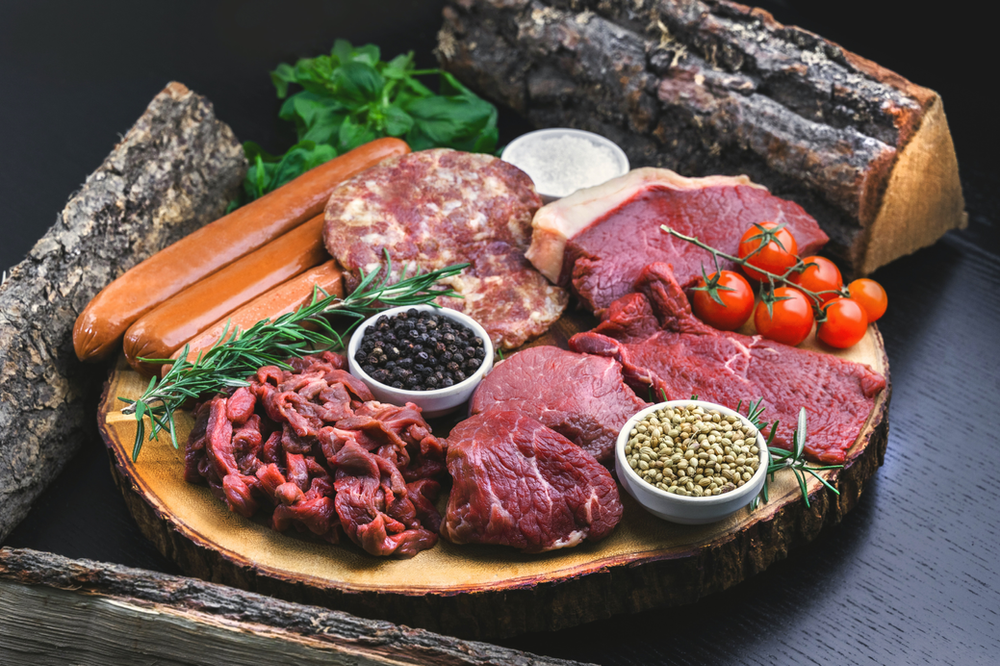Starting a carnivore diet can be a big change, and many people think it can make them healthier. People praise it for the good things it can do for health and metabolism. But, getting into ketosis, a state where the body burns fat efficiently, isn't always easy. Even if someone follows the carnivore lifestyle closely, they might wonder, ",Why am I not in ketosis on a carnivore diet?" Figuring this out means looking closely at different things that affect ketosis. In this exploration, we'll dig into details like how much protein we eat, the kinds of fats we choose, and why some carbs might sneak in.
We'll unravel these complexities to find answers to this common question. Come along as we navigate the twists and turns of the carnivore journey and try to figure out how to make the path to ketosis even better.
What is the Carnivore Diet?
The carnivore diet is a dietary approach centered around the consumption of animal products exclusively. Advocates of this regimen believe that eliminating plant-based foods can optimize health by focusing on nutrient-dense sources such as meat, fish, and animal fats.
Importance of Ketosis for Carnivores
Ketosis, a metabolic state where the body burns fat for fuel instead of carbohydrates, is a key aspect of the carnivore lifestyle. When you decide to follow the carnivore diet, the goal is to achieve and maintain ketosis to harness its potential benefits, including enhanced fat loss, increased mental clarity, and improved energy levels.
Common Misconceptions, Achieving, and Maintaining Ketosis
- Excessive Protein Consumption: Contrary to popular belief, excessive protein intake on a carnivore diet might hinder ketosis by converting excess protein into glucose. Striking the right balance between protein and fat is crucial for optimal results.
- Neglecting Fat Quality: Not all fats are created equal. Some misconceptions involve neglecting the importance of high-quality fats, such as omega-3 fatty acids. Including a variety of healthy fats in the diet is essential for supporting ketosis.
- Overlooking Carbohydrate Sources: While the carnivore diet is primarily carbohydrate-free, hidden carbohydrates in processed meats or condiments can unknowingly disrupt ketosis. Being mindful of all potential carbohydrate sources is key.
- Ignoring Individual Variations: Achieving and maintaining ketosis can vary from person to person. Genetic factors, hormonal influences, and personal metabolic rates play a significant role. Recognizing and adapting to individual differences is crucial for success.
By dispelling these misconceptions, individuals can optimize their carnivore diet for ketosis, unlocking the full spectrum of potential health benefits.
Definition of Ketosis and Its Metabolic Significance
Ketosis is a metabolic state in which the body shifts from using carbohydrates as its primary energy source to relying on ketones, which are produced from stored fat. This natural process plays a crucial role in metabolism, offering various health benefits, including weight loss and improved energy levels.
Initiating Ketosis
The body enters ketosis through a reduction in carbohydrate intake, prompting a decrease in blood glucose levels. This scarcity of glucose signals the liver to increase the production of ketones from stored fats. As the body adapts to this shift, ketosis is initiated, leading to the utilization of fat stores for energy.
Ketosis and Fat Adaptation
Ketosis and fat adaptation go hand in hand in the metabolic journey. Fat adaptation refers to the body's ability to efficiently use fat as its primary fuel source. The prolonged state of ketosis fosters fat adaptation, enhancing the body's capacity to burn stored fats for energy. This symbiotic relationship promotes improved endurance, mental clarity, and overall metabolic flexibility.
Understanding the intricacies of ketosis, from its definition to the body's initiation process and its interconnectedness with fat adaptation, empowers individuals to make informed decisions about their dietary choices. Embracing this metabolic state can lead to optimized health and wellness outcomes.

Protein Intake and Its Crucial Role in Ketosis
Balancing protein intake is pivotal for achieving and maintaining ketosis on a carnivore diet. While protein is essential, excessive consumption may lead to gluconeogenesis, where the body converts protein into glucose, potentially hindering ketosis. Finding the optimal protein-fat ratio is key to supporting ketosis effectively.
Types of Fats Consumed: Crafting the Ketogenic Blueprint
The types of fats consumed play a significant role in influencing ketosis. Embracing healthy fats, such as saturated fats and monounsaturated fats, while being mindful of omega-3 and omega-6 fatty acids, can foster a conducive environment for sustained ketosis. Understanding the composition of dietary fats is crucial for optimizing metabolic outcomes.
Carbohydrate Sensitivity and Unveiling Hidden Carbs
Carbohydrate sensitivity is a crucial factor affecting ketosis on a carnivore diet. Even though the diet is primarily carb-free, hidden sources of carbohydrates in processed meats or condiments can inadvertently disrupt ketosis. Identifying and avoiding these hidden carbs is essential for those committed to maintaining a ketogenic state.
Individual Variations in Metabolic Response
Metabolic responses to the carnivore diet can vary significantly among individuals. Genetic factors, hormonal influences, and personal metabolic rates all contribute to these variations. Recognizing and respecting individual differences allows for a tailored approach, ensuring that each person can optimize their diet for ketosis based on their unique physiology.
Understanding these influential factors provides a comprehensive perspective on achieving and sustaining ketosis on a carnivore diet. By addressing protein intake, selecting appropriate fats, being vigilant about hidden carbs, and acknowledging individual metabolic variations, individuals can navigate the carnivore lifestyle more effectively to support their ketogenic goals.
Protein Metabolism and Gluconeogenesis: Navigating the Ketogenic Path
Understanding protein metabolism is crucial in the pursuit of ketosis on a carnivore diet. Excessive protein consumption can trigger gluconeogenesis, a process where the body converts protein into glucose. This conversion may elevate blood sugar levels, potentially hindering the desired state of ketosis. Striking a delicate balance is essential for reaping the benefits of both protein and ketosis.
The Role of Amino Acids in Ketosis: Building Blocks of Metabolic Success
Amino acids, the building blocks of protein, play a significant role in the ketotic journey. Certain amino acids can be converted into glucose, impacting insulin levels and potentially disrupting ketosis. However, understanding the nuanced interplay between amino acids and ketosis allows for strategic dietary choices that support metabolic efficiency and sustained ketosis.
Finding the Optimal Protein-Fat Ratio: Customizing the Ketogenic Blueprint
Achieving the ideal protein-fat ratio is the cornerstone of a successful carnivore diet aimed at maintaining ketosis. This balance varies among individuals, and finding the sweet spot is essential. A customized approach considers factors like activity level, metabolic rate, and individual tolerance, ensuring that protein intake aligns harmoniously with fat consumption for optimal ketotic outcomes.
Striking the right balance between protein and ketosis involves a nuanced understanding of protein metabolism, the role of amino acids, and the personalized adjustment of the protein-fat ratio. By navigating this delicate equilibrium, individuals can harness the benefits of both protein and ketosis, unlocking a path to metabolic success on their carnivore journey.

Saturated Fats, Monounsaturated Fats, and Ketosis: Decoding the Fat Connection
Understanding the impact of dietary fats on ketosis is essential for carnivore diet enthusiasts. Saturated fats and monounsaturated fats are key players in promoting ketosis, serving as efficient sources of energy that align with the low-carb principles of the carnivore lifestyle. Exploring this fat connection can enhance metabolic outcomes on the ketogenic journey.
The Importance of Omega-3 and Omega-6 Fatty Acids in a Carnivore Diet
Incorporating omega-3 and omega-6 fatty acids is critical for maintaining a balanced carnivore diet that supports ketosis. While omega-3s contribute anti-inflammatory properties, omega-6s, in excess, may have pro-inflammatory effects. Striking the right balance between these fatty acids is essential for optimizing metabolic health and ensuring a sustainable ketogenic state.
Incorporating a Variety of Fats for Nutritional Balance
Attaining a balanced mix of nutrients on a carnivore diet means carefully including various types of fats. This diversity ensures a range of essential nutrients, promoting overall well-being. Incorporating fats from different sources enriches the nutritional content of the diet, sustaining ketosis while addressing the diverse needs of the body.
To optimize the fat composition in a carnivore diet, one must understand saturated and monounsaturated fats, strike a balance between omega-3 and omega-6 fatty acids, and include a variety of fats. Strategically managing these aspects enhances the advantages of ketosis, fostering not only the immediate benefits but also promoting long-term nutritional balance and overall health.
Hidden Carbohydrates in Meat Products and Processed Foods
Carbohydrate awareness is crucial on a carnivore diet, as hidden carbs can lurk in unexpected places, including meat products and processed foods. Hidden carbohydrates can be elusive, often concealing themselves in unexpected corners of our diets. Processed and packaged foods are common culprits, with seemingly innocent items like condiments, sauces, and dressings containing sugars and starches.
Even seemingly carb-free products may harbor hidden sugars or fillers. In the realm of meat products, certain processed meats may be cured or marinated with carbohydrate-laden ingredients. Additionally, delving into the world of low-carb snacks and energy bars requires a discerning eye, as some may contain hidden sugars or high-carb additives. Awareness is the key, prompting individuals on low-carb or carnivore diets to scrutinize labels diligently and stay vigilant against the stealthy presence of hidden carbohydrates in various food choices.
Impact of Trace Carbs on Ketosis: Navigating the Fine Line
Even trace amounts of carbohydrates can exert a significant influence on ketosis within the confines of a carnivore diet. Ketosis, the metabolic state where the body predominantly burns fat for energy, can be sensitive to even minimal carbohydrate intake.
Trace carbs, found in unexpected sources or hidden additives, have the potential to disrupt the delicate balance necessary for sustained ketosis. The body's preference for utilizing ketones over glucose means that even a slight increase in carbohydrate intake can prompt a shift away from the desired metabolic state. Therefore, individuals adhering to a carnivore diet must remain meticulous in their food choices, ensuring that they minimize and monitor all potential sources of carbohydrates to effectively maintain the ketogenic environment they seek.
Strategies for Avoiding Unintentional Carb Intake: Crafting a Carb-Conscious Lifestyle
Crafting a carb-conscious lifestyle involves implementing strategic strategies to avoid unintentional carb intake. This may include scrutinizing food labels, choosing unprocessed meats, and staying vigilant about ingredient lists. By adopting these proactive measures, you can navigate the carnivore diet with precision, minimizing the risk of unintentional carb consumption and supporting their ketosis goals.
Maintaining carbohydrate awareness, identifying hidden carbs, understanding their impact on ketosis, and implementing effective strategies for avoidance are key elements of a successful carnivore diet. By incorporating these insights, individuals can stay on track with their ketogenic journey while enjoying the benefits of a carb-conscious lifestyle.

Plateaus in Ketosis: Strategies to Overcome and Prevail
Breaking through plateaus in your ketogenic journey requires a thoughtful approach and effective strategies to reignite progress toward health and wellness goals. Here are some key strategies to help you overcome plateaus and experience renewed success on your ketogenic path:
1. Intermittent Fasting: Incorporating intermittent fasting into your routine can be a powerful tool to break through plateaus. Fasting periods give your body the opportunity to deplete glycogen stores and shift into deeper ketosis, promoting fat burning and metabolic flexibility. Experiment with different fasting schedules to find what works best for you.
2. Adjusting Macronutrient Ratios: Fine-tuning your macronutrient ratios, particularly the balance between fats and proteins, can have a significant impact on ketosis. Too much protein can be converted into glucose through gluconeogenesis, potentially hindering ketosis. Experiment with adjusting your protein and fat intake to find the optimal ratio that supports ketosis while meeting your nutritional needs.
3. Incorporating Periodic Carb Cycling: Introducing strategic periods of carb cycling can shock the body out of a plateau. Briefly increasing carbohydrate intake and then returning to a strict low-carb approach can stimulate metabolic flexibility and encourage the body to burn stored fat more efficiently.
4. High-Intensity Interval Training (HIIT): Revitalize your exercise routine with high-intensity interval training. HIIT has been shown to enhance fat burning and improve insulin sensitivity, both of which are crucial for maintaining ketosis. Short, intense bursts of exercise followed by periods of rest can boost metabolism and break through plateaus.
5. Tracking and Tweaking: Keep a meticulous record of your dietary habits, exercise routines, and ketone levels. Analyze this data to identify patterns and potential areas for improvement. Small adjustments, such as changing meal timing or trying new recipes, can make a significant difference in overcoming plateaus.
6. Stress Management: Chronic stress can stall progress on a ketogenic journey. Incorporate stress-management techniques such as meditation, deep breathing exercises, or yoga into your routine. Managing stress not only supports mental well-being but also positively influences hormonal balance and metabolic function.
7. Prioritizing Sleep: Quality sleep is a cornerstone of overall health and can impact metabolic outcomes. Ensure you are getting sufficient, restful sleep to support your body's recovery and optimize hormonal regulation, contributing to a more effective ketogenic experience. Remember, breaking through plateaus is often a matter of experimenting with different strategies to find what works best for your body. By incorporating these effective approaches, you can revitalize your ketogenic journey, ensuring continual progress toward your health and wellness goals.
The Impact of Stress and Sleep on Ketosis: Unveiling the Connection
The connection between stress, sleep, and ketosis is a fascinating interaction that has a big impact on how your body works when you're on a carnivore diet. Figuring out how taking care of stress and making sure you get good sleep can help your ketosis is important in understanding the overall picture of your health and well-being.
1. Stress Management and Ketosis: Balancing Hormones for Metabolic Harmony
Chronic stress triggers the release of cortisol, a hormone that can disrupt metabolic processes, potentially hindering ketosis. By adopting stress management techniques such as mindfulness, meditation, or exercise, individuals can mitigate the impact of cortisol, creating a hormonal environment more conducive to ketosis. Striking this balance is pivotal for maintaining metabolic harmony and optimizing the body's ability to burn fat for energy.
2. Quality Sleep as a Ketogenic Ally: Repairing and Rejuvenating the Body
Quality sleep is a cornerstone of overall well-being, and its influence extends to the success of a carnivore diet. During the restorative phases of sleep, the body undergoes essential processes such as cellular repair and hormone regulation. Insufficient or disrupted sleep can lead to increased cortisol levels and insulin resistance, potentially jeopardizing ketosis. Prioritizing quality sleep becomes a powerful tool for supporting metabolic outcomes on a carnivore diet.
3. Synergy between Stress Reduction and Sleep Quality: Elevating Metabolic Resilience
The combined impact of reducing stress and getting good sleep creates a powerful effect that boosts the body's ability to handle changes in metabolism. When stress is effectively managed, and sleep quality is a priority, the body can better control hormones, handle insulin more efficiently, and keep blood sugar levels steady. This balanced state creates an environment where ketosis, the process of burning fat for energy, can work really well, supporting effective fat burning and overall metabolic health.
In simpler terms, the connection between stress, sleep, and ketosis is complex and deep. Managing stress and making sure you get good sleep contribute to a metabolic environment that's favorable for ketosis. This is especially important for individuals following a carnivore diet, allowing them to experience the full range of health benefits. By understanding and dealing with these linked factors, individuals can improve their metabolic health and set off on a path toward long-lasting well-being.

Monitoring Ketone Levels: Fine-Tuning the Carnivore Diet for Success
Leveraging ketone monitoring is a powerful tool for gaining insights into your metabolic state and making informed adjustments to your diet on a ketogenic journey. Here's a step-by-step guide on how to effectively utilize ketone monitoring for optimal results:
1. Choose the Right Monitoring Method: Select a reliable ketone monitoring method that suits your preferences and lifestyle. Common methods include blood ketone meters, breath analyzers, and urine strips. Blood ketone meters are considered the most accurate for real-time measurements.
2. Establish a Baseline: Before making any adjustments, establish a baseline by consistently monitoring your ketone levels over a specific period. This baseline provides a reference point and helps you understand your body's typical response to your current dietary and lifestyle practices.
3. Set Clear Goals: Define your health and wellness goals, whether it's achieving a specific level of ketosis for weight loss, mental clarity, or other benefits. Clear goals will guide your adjustments and help you tailor your diet to meet your individual objectives.
4. Monitor Regularly and Consistently: Consistency is key when monitoring ketone levels. Choose specific times for monitoring, such as in the morning or after meals, and adhere to this schedule. Regular monitoring provides a comprehensive picture of how your body responds to different factors.
5. Analyze Patterns and Trends: Track and analyze patterns and trends in your ketone levels. Look for correlations with dietary changes, exercise, stress levels, and other lifestyle factors. Identifying patterns can reveal insights into what positively or negatively influences your metabolic state.
6. Experiment with Dietary Adjustments: Use your ketone measurements as a guide to experiment with dietary adjustments. For example, if ketone levels are consistently lower than your goal, consider adjusting your macronutrient ratios, reducing carb intake, or modifying your fasting schedule. Periodically reassess and refine your approach based on the results.
7. Consider the Context: Ketone levels are influenced by various factors, including exercise, hydration, and individual metabolic differences. Consider the context surrounding your measurements, and avoid making drastic changes based on isolated readings. Look for consistent trends over time.
8. Consult with a Professional: If you're uncertain about interpreting your ketone measurements or making adjustments, consider consulting with a healthcare professional or nutritionist. They can provide personalized guidance based on your unique health profile and goals.
9. Be Patient and Adaptive: Achieving and maintaining optimal ketosis is a gradual process. Be patient and adaptive in your approach. Your body may require time to adjust to changes, so monitor consistently and make adjustments incrementally.
By using ketone monitoring systematically, you can get important information about how your body is working. This smart approach helps you make specific changes to your diet, making sure you're getting the best results from your ketogenic lifestyle and getting closer to your health goals.
When dealing with common problems on a carnivore diet, like getting stuck at a certain point in ketosis, managing stress and sleep, and keeping an eye on your ketone levels are key actions. By putting these strategies into action, you can face challenges with certainty, enhance your carnivore lifestyle, and reach long-lasting success in your journey to better health and wellness.
Recap: Why Am I Not in Ketosis on a Carnivore Diet?
Achieving ketosis on a carnivore diet involves considering crucial factors that significantly influence the body's metabolism. These factors range from comprehending how proteins are processed in the body and understanding the composition of dietary fats to being conscious of concealed carbohydrates and recognizing the individual differences in how our bodies respond.
The success of the carnivore lifestyle hinges on the intricate balance between macronutrients, the quality of fats ingested, and maintaining awareness of carbohydrate intake. These components collectively determine the body's capacity to enter and sustain the state of ketosis, where it efficiently burns fats for energy.
Emphasizing the Importance of Individualized Approaches
Individualized approaches are crucial in the world of carnivore diets and ketosis since one size doesn't fit everyone. Recognizing the significance of tailoring dietary choices to fit personal needs is vital. Genetic factors, hormonal influences, and metabolic responses vary from person to person. Acknowledging these differences allows for a customized approach, ensuring that dietary decisions align with individual requirements. Whether it's adjusting the protein-fat ratio or being mindful of hidden carb sources, customization is the key to unlocking the complete benefits of the carnivore lifestyle.
Embarking on a carnivore diet journey demands a deep understanding of metabolic intricacies alongside persistence and adaptability. Challenges and unforeseen factors may arise, but maintaining persistence in achieving ketosis is essential. Celebrate successes, learn from setbacks, and stay adaptable in your approach. The ability to troubleshoot common issues, experiment with dietary adjustments, and use tools like ketone monitoring reflects a commitment to long-term success.
All in all, achieving and sustaining ketosis on a carnivore diet is a dynamic and personalized journey. By summarizing the key factors, highlighting individualized approaches, and encouraging persistence and adaptability, individuals can navigate the complexities of the carnivore lifestyle confidently. The path to ketosis is unique for each person, and the journey is as significant as the destination. Continue refining your approach, stay committed to health goals, and embrace the transformative power of the carnivore lifestyle.






